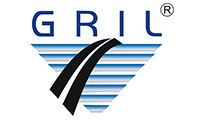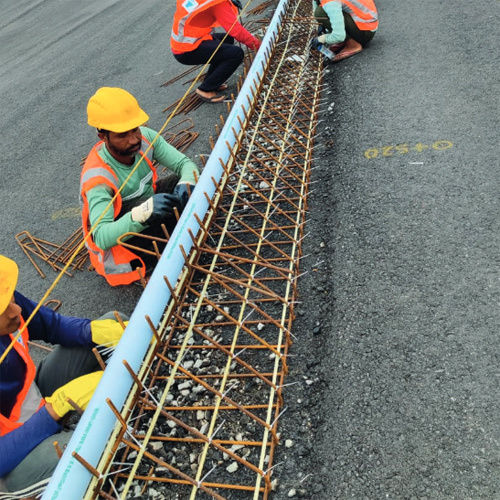Glass Fibre Reinforced Polymer-GFRP Rebars
Product Details:
- Product Type Glass Fibre Reinforced Polymer-GFRP Rebars
- Material Polymer
- Width Different available Millimeter (mm)
- Thickness Different available Millimeter (mm)
- Application Industrial
- Click to View more
Glass Fibre Reinforced Polymer-GFRP Rebars Price And Quantity
- 10 Ton
Glass Fibre Reinforced Polymer-GFRP Rebars Product Specifications
- Industrial
- Polymer
- Different available Millimeter (mm)
- Glass Fibre Reinforced Polymer-GFRP Rebars
- Different available Millimeter (mm)
Glass Fibre Reinforced Polymer-GFRP Rebars Trade Information
- Cash in Advance (CID)
- 100 Ton Per Month
- 15-30 Days
- All India
Product Description
Glass Fibre Reinforced Polymer-GFRP Rebars are reinforcement materials employed in the construction of concrete. Their corrosion resistance makes them a cost-saving, long-term option for reinforced coastal concrete, bridges, and parking garages. They have better durability in extreme environmental conditions, prolonging the structure's lifespan. The lighter quality assists in lessening the total weight of the structure, something that may be of concern for some forms of construction, like high-rise buildings or retrofitting work. Glass Fibre Reinforced Polymer-GFRP Rebars provide a better substitute to ordinary steel rebars in concrete reinforcement, especially in conditions where water exposure, salt, or harsh chemicals are present.
Designed to meet Bharats growing infrastructure needs with precision and quality, we are crafting premium GFRP Rebars in Ahmedabad. Our products meet the highest standards of Bureau of Indian Standards IS-18256:2023 and other International Standards.
GFRP Rebars is a revolutionary solution to corrosion vulnerabilities. We offer unparallel resistance to chloride-ion attacks, providing a robust alternative for non-prestressed reinforcement in concrete elements subjected to flexure, shear, and compression loads. These composite rebars have a tensile strength upto 2x greater than traditional steel yet, weigh a mere 25% of their steel counterparts. Furthermore, GFRP Rebars serve as excellent electromagnetic and thermal insulators
Salient Features
- Non-corrosive, rust-resistant and durable.
- Lightweight & high
- strength-to-weight ratio.
- Electric & thermal insulation
- for heat resistance.
- Non-conductive & non-electromagnetic.
- Non-magnetic, contain no ions, for areas in
- close proximity to magnetic apparatus.
Applications and Uses
- Reduces maintenance costs in extreme climates and hilly terrains where deicing salts are heavily utilized.
- Shields structures from the corrosive effects of seawater, including caissons, decks, piles, canals and roads.
- Resilient against corrosion from chemical processing industries to industrial wastewaters,
- treatment plants, petrochemical plants pulp and paper mills, cooling towers and chimneys.
- Low electrical conductivity or electromagnetic neutrality such as, aluminum and copper smelting plants, structures supporting electronic equipment (e.g. transmission towers), Magnetic Resonance Imaging (MRI) facilities etc
GFRP Rebar V/s Steel Rebar
|
Specification |
GFRP Rabar |
Non-alloy Steel Rebar |
Benefits of FRP |
|
Corrosion resistance |
Very high |
Very low |
More durability |
|
Durability |
Min 80 years |
By building code |
More durability |
|
Tensile strength |
1100 MPa |
425-550 MPa |
Stronger |
|
Modulus of elasticity |
55 GPa |
200 GPa |
Straightening not required |
|
Density |
1.9 g/cm3 |
7.85 g/cm3 |
Light weight |
|
Relative elongation |
< 2.5% |
25% |
Minimal stress induced deformation |
|
Electric conductivity |
Dielectric |
Conductive |
Minimal accidental risk |
|
Magnetic property |
Non magnetic |
Magnetic |
|
|
Coefficient of thermal conductivity |
< 0.56 W/m.K |
> 46 W/m.K |
Structural stability prolonged life |
|
Standard length |
12 m/customizable |
12 m(usually |
Less wastage/ easy handling |
Our Assurance
|
Property |
Guarantee |
|
Guaranteed glass fibre content (mass fraction) |
80% |
|
Mean glass transition temperature (Tg)/ midpoint temperature |
100 Degree C |
|
Mean degree of cure |
95% |
|
Guaranteed transverse shear strength |
130 Mpa |
|
Guaranteed bond strength |
7.6 Mpa |
|
Mean residual fatigue tensile strength |
60% |
|
Creep failure criteria at a sustained service stress level of 35 percent of ultimate tensile strength |
No rupture |
|
Mean moisture absorption (short term) |
0.25% |
|
Mean moisture absorption (long-term) |
1% |
|
Guaranteed residual tensile force after 90 days of immersion in alkaline solution at 60 Degree C |
80% of mean ultimate tensile force of pristine bars |
Weight & Tensile Force Compared to Steel Rebar
|
Size |
GFRP Rebar |
Steel |
|||
|
Bar Size Designation |
Dia (mm) |
Nom. Cross Sec. Area (Sq. mm) |
Weight (g/m) |
Minimum Guaranteed Ultimate Tensile Force (kN) |
Weight (g/m) |
|
G4 |
4 |
12.60 |
26 |
11 |
98 |
|
G6 |
6 |
28.30 |
55 |
23 |
222 |
|
G8 |
8 |
50.30 |
98 |
40 |
395 |
|
G10 |
10 |
78.60 |
148 |
60 |
620 |
|
G12 |
12 |
113.10 |
220 |
80 |
890 |
|
G14 |
14 |
154.00 |
298 |
105 |
1210 |
|
G16 |
16 |
201.10 |
588 |
130 |
1580 |
|
G18 |
18 |
254.50 |
490 |
160 |
2000 |
|
G20 |
20 |
314.20 |
603 |
190 |
2470 |

Price:
- 50
- 100
- 200
- 250
- 500
- 1000+





 Send Inquiry
Send Inquiry Send SMS
Send SMS Call Me Free
Call Me Free